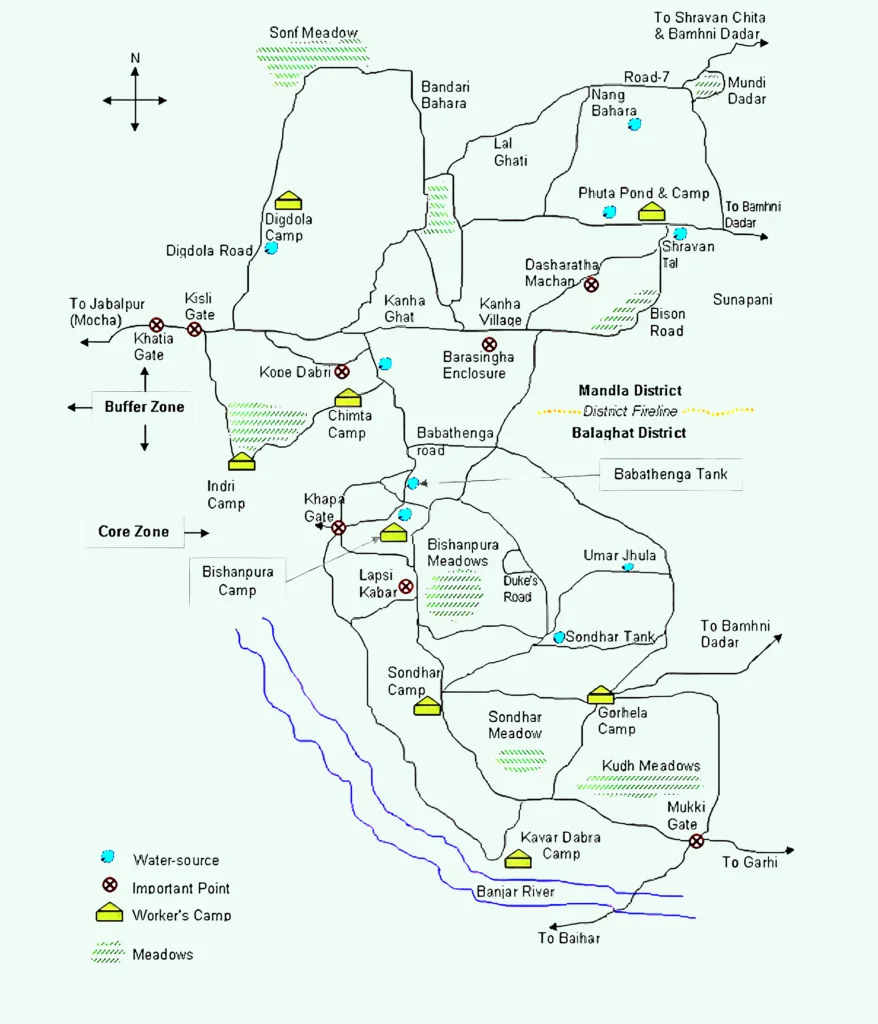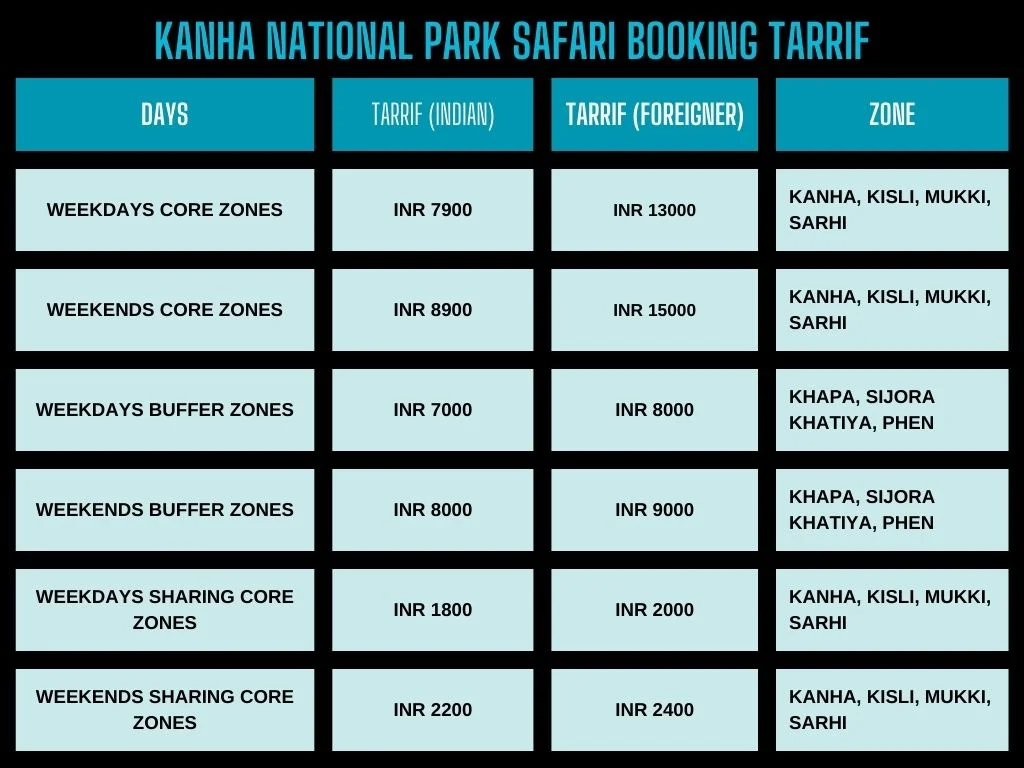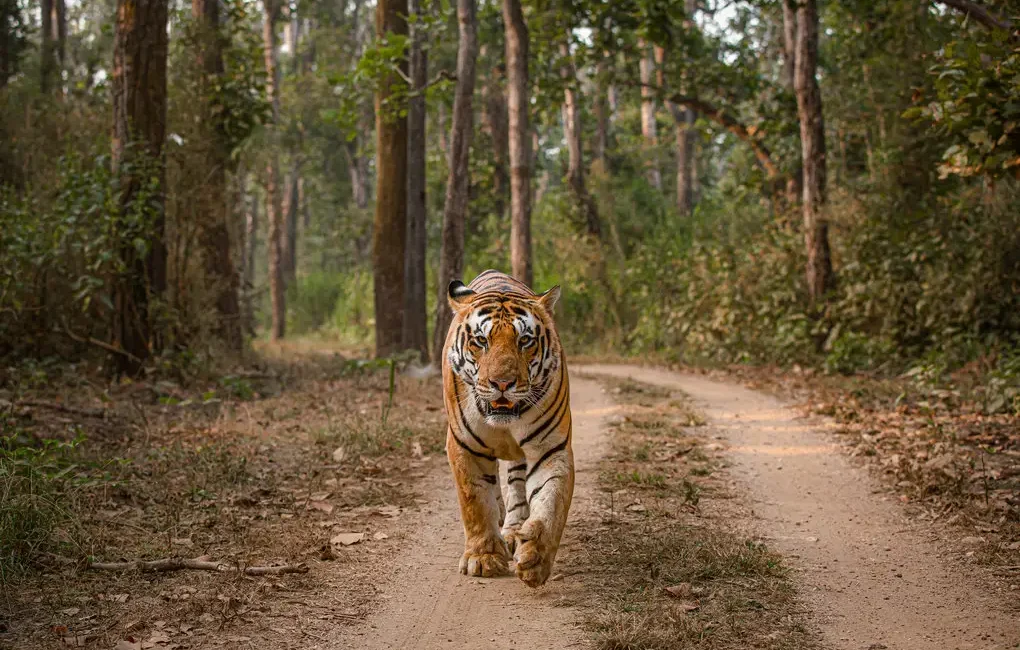Located in the central part of India, Kanha is one of the renowned wildlife reserves of the world. Stretched in an area of 940 square kilometers in Madhya Pradesh, this marvelous park includes vibrant green vegetation, huge forests, expansive meadows, and a prominently wide variety of wildlife. Kanha National Park famous for the amazing conservation program designed for this park, and as one of the most favourable destinations to come across the Bengal tiger in the wild. This is the best travel guide for Kanha National Park where you would be able to know all the information about everything you need to know to visit this beautiful tiger reserve.
Why Should You Visit Kanha National Park?
The Kanha National Park has been one of the most sought after paradise for the lovers of wildlife and nature curiosities for as long as four decades now. Having amazing bio-diversity and being one of the early launching sites of Project Tiger in Indian wildlife history, it is an important place for wildlife conservation in India. Here are some of the top reasons why you should visit Kanha National Park:
Here are some of the top reasons why you should visit Kanha National Park:
1. Tiger Sighting: Presently a large population of the Bengal tigers, it is one of the finest locations in India to find big cats in nature.
2. Stunning Landscapes: Kanha National Park comprises different land features that include: broad leaved sal forests and bamboos, spacious meadows as well as rivers. For further details, it can be said that the naturalness and untainted look of the park cannot be described.
3. Rich Wildlife: Indirectly, tigers, leopards, wild dogs which are known as dhole, sloth bear and there are around more than 300 varieties of birds also. Other animals that are found here and which are in the list of endangered species include the Barasingha or the swamp deer which has been revived due to conservation programmes encouraged in the park.
4. Eco-Tourism at Its Best: Kanha supports the concept of eco-tourism, conservation efforts for plants and animals and that are useful to the local people as well. It is a very good place for those species that want to enjoy nature while obeying the laws.
With all the information about what makes Kanha so special out of the way, now let’s get into the nuts and bolts of making your visit happen.
Zones in Kanha National Park
The Kanha National Park has four vital regions that it is composed of as the central zones and several other important zones known as the buffer zones. All the zones are different in terms of geography and wildlife movement thus giving a different Safari experience. Today, it is relevant to know these zones in order not to lose sight of a tiger within the framework of a safari, because some zones are more preferred.
Entry Gate Information (Allowed Vehicles in Different Zones through all Gates)

1.Kisli Zone
Best For: Tiger spotting, wild life; birds, The Tala Zone: Tigers, leopards, wild boar, giant squirrels etc.; Srun Voluntea: Various wild life, birds etc.
Highlights: Kisli is very old zone in the park area and is famous for wildlife and natural landscaped areas of the park. It is quite easy to sight tiger, leopard, wild dog, and the Barasingha in this park.
2. Mukki Zone
Best For: Integrated bird watching & flora-fauna; watching tigers in their natural habitats.
Highlights: Mukki is one of the key points of interest part of the southern area of the park and interesting especially for fans of wildlife. The vegetation here is somewhat thinner; thus it becomes quite easier to see the animals. The zone also hosts different bird species ranging from eagles, vultures among others as well as different types of owls.
3. Kanha Zone:
Best For: Tigers are the animals of interest associated with the kind of habitat, dense forests.
Highlights: The Kanha zone is all the more popular because it comprises extensive meadow and heavy forest areas. It is among the favourite areas for visiting by tourists because there one can have incredible opportunities to track tigers in summer. Barasingha also forms large groups in meadows inside Kanha Park.
4. Sarhi Zone:
Best For: Scenery is very important during a safari and here I was to find a quiet time full of nature.
Highlights: Sarhi is little less boisterous compared to the other zones and thus more suitable for those who wish to spend their time enjoying the wildlife. The concerned zone is comprised of forests and grasslands and it provides the view of tiger, leopard, and deer.
Beyond the core zones there are the buffer zones and these are a ring around the core areas. Safaris in these buffer zones are cheaper, and they normally attract fewer visitors as an implication of charging relatively cheaper fees. These offer very good prospects for observing different species of animals and are especially interesting for bird watchers.
1. Khapa Buffer Zone
The Khapa buffer zone is one of the younger zones for the safari tour in Kanha. It was depicted as having vast areas of plains, woods and tall grasses expanses of the country side. Though not much renowned as the latter, Khapa assists incredible opportunities in sightseeing tigers, leopards, gaurs and barasingha.
2. Khatia Buffer Zone
Being a buffer zone this subzone is easily accessible and situated near the Khatia Gate. It has jeep safaris and has numerous wildlife. It has a comparatively low altitude and the slopes are comparatively gentle hence the grassland is well exposed to human activities and this best area to see most of the herbivores such as chital and sambar.
3. Phen Buffer Zone
The Phen buffer zone is relatively less explored and hence you get to explore somewhat more raw and isolated type of Safari. They recommend it for visitor interested in a natural unfenced wildlife environment since this has high density bamboo trees. Phen is also famous for bird watching and, rare possibilities of sighting tigers and sloth bears.
4. Sijhora Buffer Zone
The Sijhora buffer zone thus has activities such as nature walks, jeep safaris and village tours exposing the tourist to the culture of the park people in addition to the wildlife. It is a great place for the tourism enthusiasts who wish to go beyond having the normal tiger tracking experience.

Safari Experience in Kanha National Park
Undoubtedly the most exciting part of travelling to Kanha National Park is the safari tours. It has jeep safaris in which visitors are able to view the diverse nature in various ways.
This park is most favourite for Jeep safaris and this is the most preferred and fun way to tour round the park. There is nothing like more than embarking on an expedition in the jungle to look for wildlife especially the tiger. The park allows two jeep safaris a day:
Morning Safari: morning 6:00 AM to 11:00 AM
Afternoon Safari: This is normally done between 3:00 PM and 6:00 PM although the timings may slightly change during the different seasons of the year.
Booking a Safari
Online Booking: One can plan his safari online through the official website of Madhya Pradesh Forest Department. Permits available are limited and therefore it is advisable to get to book in advance especially during the peak season.
Cost: The rates for jeep safari also differ according to the zone and season though it ranges from INR 1800 up to INR 8900 for a jeep for Indian Nationals. These vehicles are jeeps that have the carrying capacity of six persons per a jeep.

Note: This tariff is as per the rates finalised by MP Forest Department, It might increase/decrease accordingly. It will be updated if any changes will be made by the department.
Guide: A forest guide is required in all the safari ventures. The cost for the guide is most of the time incorporated in the conservational safari fees.
Wildlife of Kanha National Park
The wildlife density of Kanha Kisli National Park also creates the right setting for people who need to have a feel of diverse wildlife. Here’s a look at the key species you can expect to encounter during your visit: Here’s a look at the key species you can expect to encounter during your visit:
- Bengal Tiger: The pride of the park, the Bengal tiger is the largest and most popular resident in the park as it is one of the biggest cats in the world. Sighting of the animal may not be for certain but it remains one place in India where people can consider themselves almost certain of seeing the tiger in his natural habitat.
- Barasingha (Swamp Deer): Conservation success story of Barasingha is also mascot of the park. The Tiger which was nearly extinct has now been revived in Kanha, all the thanks going to the efforts made by the park authorities.
- Leopard: While relatively less common than tigers, leopards can be sighted quite often, and that too, most often at the Kisli and Mukki zones.
- Dhole (Indian Wild Dog): Tigress with cubs will frequently be seen at Kanha especially when the packs of dholes are available. These animals are social in nature and are famous for hunting; they are normally seen hunting in groups.
- Sloth Bear: These are less frequent, however; the sloth bear, which is a shaggy, insectivorous bear is occasionally sighted in the forest more particularly during the summer.
- Birds: Some of the avifauna present in the park include more than 300 species of birds and this has made the park to be a nightmare for bird watchers. The biosphere is home to different species, some of which are the crested serpent eagle, the Indian peafowl, Malabar pied hornbill and migratory birds.
When Is The Right Time To Visit Kanha National Park?
The most preferred season depends on one’s immediate interest since different seasons offer different experiences at the Kanha National Park park. Kanha National Park remains open for visitors from October to June but it closed for visitors during the monsoon season of July to September. Every Season brings with it something good for the tourists.
Winter (October to February)
Weather: The temperatures are quite moderate between 10°C to 25°C making this the most suitable weather for those interested in visiting the kanha national park.
Wildlife Activity: It is also easy to find most of the animals near water sources since they come for water during this time of the year. The parks’ weathers are cooler compared to other seasons making it comfortable for a safari drive and bird watching activity which is also at its best due to the presence migratory birds in these parks.
Ideal For: Family holidays, watching birds, and other recreational wildlife watching activities.
Summer (March to June)
Weather: It can get very hot in the day especially with some parts being up to 40°C, although the best times are early in the morning and late in the afternoon.
Wildlife Activity: Since water is scarce during this time, tiger and other animals come out in the open to look for water making it the best time to spot the tigers. This time the team benefits from the dry weather because the overgrown vegetation reduces during this time of the year.
Ideal For: Wildlife lovers and photographers, specifically, people who go in search of Tigers and other wildlife species.
How to Visit Kanha National Park
Kanha National Park is in Madhya Pradesh hence can easily be accessed by the different means of transport. Depending on where you’re traveling from, here are the best ways to reach Kanha Natioanl Park, Depending on where you’re traveling from, here are the best ways to reach the park:
By Air:
Jabalpur Airport (175 km): The nearest airport to Kanha is Jabalpur that is very much connected to Delhi and Mumbai also. Hiring a taxi or a bus is possible to Kanha from Jabalpur and takes about five to six hours to reach the park.
Nagpur Airport (260 km): Another is coming in through Nagpur, the largest city of the Division and administrative services hub. Even though it is located at a relatively greater distance from the two cities, there are more flights with better connectivity from Nagpur as compared to other cities.
Raipur Airport (220 km): One can also drive down to Kanha from the capital of Chhattisgarh which is Raipur and the distance is approximately 260-300 km and it really takes 4-5 hours.
By Train:
The nearest railway station is Jabalpur Railway Station which is 160 km away from the city. Its railway connection include the halt of trains originating from several large cities such as Delhi, Mumbai, and Kolkata etc. Once you get to Jabalpur it is advisable to get a taxi or board a bus to Kanha.
By Road:
The accessibility of Kanha National Park is quite easy through the roads. One can approach Jabalpur ( 165 Kms ), Nagpur ( 270 Kms ) or Raipur ( 215 Kms) by cars. The roads are fairly well maintained, and the passing scenery comprises rolling country that is easy on the eyes as you drive out of Paris.
Tips for Better Experience
1. Book Your Safari in Advance: It is difficult to obtain many permits for safari especially if it is during the high season. Booking in advance brings an added advantage in that an individual is guaranteed a chance at the particular zones of interest.
2. Choose the Right Zone: The individual zones are different so study which one is best for the several types of wildlife you are interested in.
3. Pack Accordingly: The best time to visit Kanha is anytime of the year, but it’s always wise to carry light cotton apparels for summers as also carry thicker clothes for winter for the safaris. Do not carry along your camera, binoculars and the sun cream.
4. Respect Wildlife: It is such a great feeling when one gets to see a tiger and other animals out there however, always respect the space of those animals. Do not make much noise and pamper all the directions it will guide on.
5. Stay Hydrated: It will be wise to note that no matter what time of the year you will be visiting the country, your safaris may be long. It is recommended that whenever you are going out always have a bottle of water with you so that you can be well hydrated.
Click the Button Below to Share the Information
Book Resort/Hotel in Kanha National Park
To Get Best Deals on all types of Resort and Hotels, Kindly Contact Us or Fill this Call me Back form:
Fore More Informations Please Contact Us

